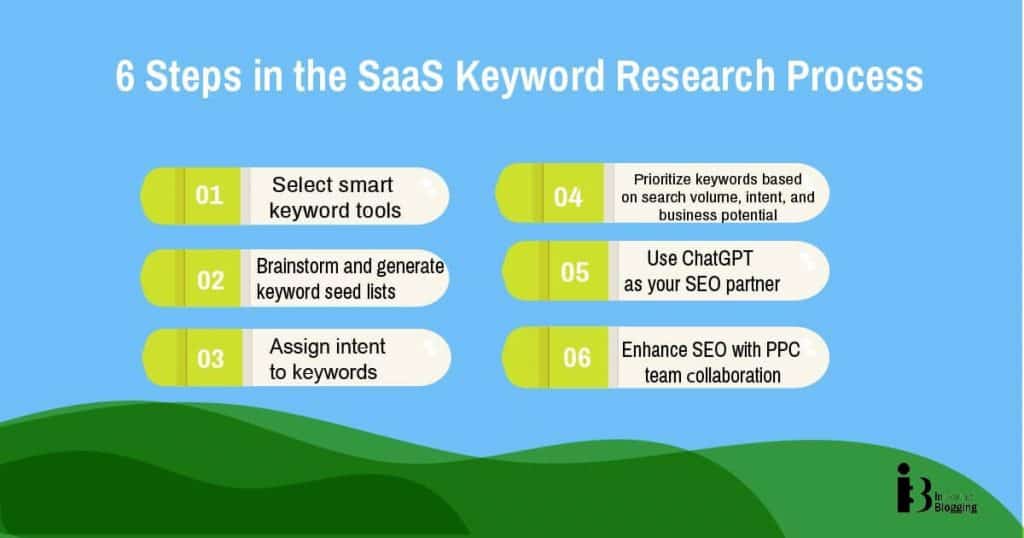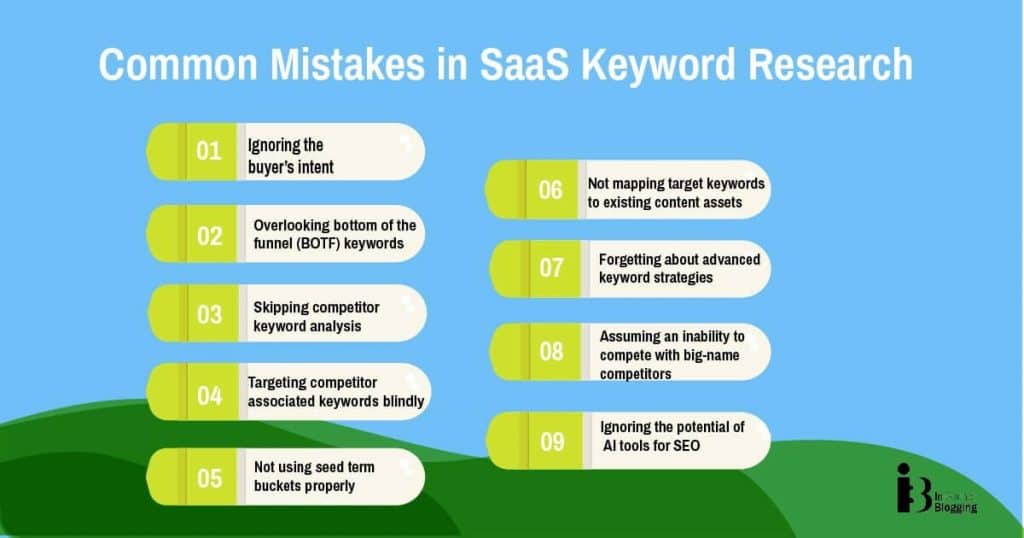Playback speed:
Finding the right keywords can be tough, especially in the software-as-a-service (SaaS) industry. I’ve been there; trying to connect with my target audience felt overwhelming until I learned and applied effective SaaS keyword research strategies.
This article shares techniques to boost visibility and create meaningful engagement and conversions. Ready to master SaaS keyword research? Keep reading for key insights.
Keyword Research for SaaS [Key Takeaways]
- Use smart tools such as Ahrefs and Semrush to find out what your audience is searching for. This helps you pick keywords that match their needs.
- Look at what your competitors are doing. Find gaps in their keyword strategies to discover new opportunities.
- Understanding your audience is key. Use customer reviews and search behavior trends to choose the right keywords.
- Incorporate long-tail keywords and specific phrases into your content. They attract the right audience and improve rankings.
- Regularly check how well your chosen keywords perform with tools such as Google Analytics. Be ready to adjust your strategy based on this data.
- Avoid common mistakes, such as overemphasizing traffic volume over buying intent, ignoring low-volume keywords with high buying intent, blindly targeting competitor-associated keywords, and assuming an inability to compete with big-name competitors.
What Is SaaS Keyword Research?
SaaS keyword research is the strategic process of identifying and analyzing search terms that potential customers use to find SaaS products online.
Keyword research is the key to unlocking success in the SaaS field. It helps you understand what your audience is looking for. This means that when they type words into Google, you want your software solution right there on the first page.
6 Steps in the SaaS Keyword Research Process

These six steps in the SaaS keyword research process guide you from brainstorming to mapping out your content strategy.
Ready to get smarter with your search engine optimization (SEO)? Let’s jump right in.
1. Select smart keyword tools
Tools, such as Google’s Keyword Planner, Semrush, and Ahrefs, are top picks. They show you search volume, competition level, and even related phrases that might not have crossed your mind.
Use keyword research tools to analyze patterns and predict which keywords will lead to conversions. These tools save me so much time by automatically prioritizing the most valuable keywords for my SaaS business clients.
I’ve tried various solutions—some focus on deep SEO insights, while others are better for quick searches or understanding content trends.
My preference leans toward keyword tools that blend usability with comprehensive real-time data. This balance lets me quickly assess keywords and make informed decisions about my strategy without getting bogged down in details.
2. Brainstorm and generate keyword seed lists
Here, I like to start with my audience in mind. What are they searching for? To figure this out, this is what I advise you to do:
- Know your ideal customer profile (ICP). It’s crucial for crafting tailored content that resonates with your target audience, ensuring your messages hit home every time, and guiding your strategy with precision.
- Identify the anti-ICP. This helps avoid wasting resources on individuals who aren’t a good fit for your offering, enabling you to focus more on prospects who genuinely matter for your business.
- Create a customer journey map to illuminate user needs and behaviors at each stage. It provides insights into crafting content that addresses them effectively and aligns with your SaaS SEO strategy.
- Understand key switch moments. It’s about identifying when customers decide they need your product. This enables you to target potential buyers with precision and craft content that speaks directly to their needs at the right time.
- Focus on the jobs to be done. This involves understanding the real problems your potential customers are trying to solve, revealing their buying intent, and helping you align your content and SEO techniques with their needs and desires.
- Consider not-so-obvious use cases. This approach expands your keyword strategy by exploring how people might use your product in ways you haven’t thought of yet, opening the door to new keyword ideas and extending your reach.
- Extend the top-of-the-funnel keywords, including broader terms, to catch people’s attention early in their search journey, building awareness and trust with your audience and guiding them toward making a decision that’s right for them.
- Analyze sales calls. This way, you can better grasp your potential customers’ pain points and desires, guiding the refinement of your SEO strategy to address real-world concerns. Besides regular discussions with your customer support and sales teams, it’s a good idea to use AI tools, such as Chorus AI and Gong, for deeper analysis.
- Get your team together for some brainstorming sessions to come up with keywords for SEO. Everyone’s input counts, and it’s a great way to cook up a keyword strategy that really hits home with your audience.
- Take time to read reviews on websites, such as G2 and Capterra, social media, and forum discussions, etc. Here, words from real users tell you more than just what they think about different software platforms. They reveal key phrases and concerns that can guide your keyword choices.
- Perform competitor analysis: Use tools, such as Ahrefs and Semrush, to analyze other sites that rank for the same keyword as yours. Find out what keywords they target for their PPC campaigns, too. This way, you can find out how to outrank your competitors.
And here’s a bonus tip by Vinika Garg, a COO at Webomaze:
“The keywords will boost the unique sales propositions of the products, seizing the attention of target customers. SaaS entrepreneurs and marketers can utilize user surveys and feedback to find such keywords. Then, they can incorporate the keywords into their SEO content, such as white papers or product guides.”
Categorize your findings into a list of keywords. This simple action will greatly facilitate your work from then on.
3. Assign intent to keywords
Assigning keyword intent, a.k.a. search intent, is like uncovering secret clues about what your audience really wants. Look at the words and phrases they use in search engines. This tells us if someone just wants information or is ready to buy a product right away.
When doing keyword research on Semrush, it shows search intent immediately. Keep in mind that it’s not 100% accurate, but overall, it’s a good starting point.
“Prioritizing intent over volume is a unique approach to using keyword research to succeed in the cutthroat SaaS market. Consider figuring out what the user intended to search for when they made those high-volume keyword selections. Using a focused approach increases relevance and engagement by ensuring that your content properly matches what users are looking for. Additionally, you get more quality leads and see improved conversion rates by optimizing for intent-driven keywords.” — Mike Falahee, Owner, Marygrove Awning
4. Prioritize keywords based on search volume, intent, and business potential
Look closely at search volume, intent, and how well they fit with your business goals. High-buying-intent words may not always show up big in SEO gadgets, but they can be gold mines for turning browsers into buyers.
When using SEO tools for keyword research, consider the keyword difficulty (KD) metric, too. It shows your real chance of ranking highly for the particular keyword. These are usually terms that have low competition but can bring in traffic that’s likely to convert into customers.
5. Use ChatGPT as your SEO partner
Although ChatGPT is designed for conversational purposes, it has broader abilities. So, ChatGPT for SEO, why not?
It helps me sort through tons of data and generate blog post ideas quickly. It also helps me create topical maps that match my content with the right keywords to draw in potential buyers at every stage of the buying journey.
“By creating content that addresses each phase—from awareness and consideration to decision-making—we ensure that our messaging resonates and engages potential customers precisely when they’re seeking information. This tailored content strategy, powered by our keyword research, significantly improves our SEO rankings, making our SaaS solutions more visible to those in need.” — Cache Merrill, Founder, Zibtek
ChatGPT can create variations of my primary keyword and question-based search queries. It’s so much more efficient compared to me typing them down from scratch for what seems like an eternity. The chatbot can also suggest what type of content to create, according to your goals.
Of course, not everything ChatGPT suggests is good and valid. I like to think of it as an additional colleague, but one that I can collaborate with at any time.
6. Enhance SEO with PPC team collaboration
Utilize Google Ad Converters to identify high-converting keywords that direct your efforts more intelligently toward attracting traffic that boosts your revenue. If you’ve got a dedicated pay-per-click (PPC) team on board, you can coordinate your efforts for better results.
Amar Ghose, the CEO of ZenMaid, explains why it’s such a good tactic:
“Collaborating with our PPC team has been pure gold in enhancing our keyword research strategy. By sharing insights and data, we’ve created a more powerful approach to SEO that drives engagement and conversions. This partnership allows us to understand and leverage the dynamics of paid and organic search within the same digital space, optimizing our visibility and performance in the competitive SaaS market. Through this collaboration, we’ve refined our targeting, improved our content, and ultimately increased our impact on reaching and converting our target audience.”
Learn how to supercharge your online presence through effective SEO and PPC collaboration.
Integrating Keywords Into Your SaaS Marketing Content
Putting keywords into your SaaS marketing content is like planting seeds in a garden. You need the right words—your seeds—to grow your online presence.
This practice makes sure people see your content when they search online.
It’s about mixing the perfect blend of these words into what you share with the world—making every sentence count toward drawing more eyes to what you offer.
Crafting content around targeted keywords
Creating content with specific keywords is like using a map to guide people right to our doorstep. We use terms that our potential customers type into search engines. The trick is to make sure those keywords fit naturally within valuable and informative pieces.
I also balance keyword use with keeping things interesting for readers. For example, if someone is looking for a “guide to SaaS keyword research,” I’d include that phrase in an article filled with tips and strategies on the topic. This way, I attract visitors looking specifically for what we offer while ensuring they stick around by providing them with value.
“At Verpex, we use keyword research to understand our audience’s search intent and tailor our content to meet their needs. For example, we discovered that “best web hosting for small businesses” was a highly searched term. We created a detailed blog post comparing our hosting plans, highlighting features that cater to small businesses. This resulted in increased organic traffic and conversions from small business owners looking for reliable hosting solutions.” — Julia Lozanov, Chief Editor, Verpex
Implementing topic clusters and pillar content strategy
Creating a pillar content strategy involves setting up a main piece of content that covers a broad topic in depth. This is your pillar page. It acts as the cornerstone of your SEO and content marketing efforts for SaaS.
Surrounding this, you build smaller, focused articles or blog posts—these are your topic clusters. They delve into specifics under the umbrella of the main topic, linking back to the pillar content. The beauty here is twofold: search engines see your site as an authority on the subject, and visitors find a treasure trove of useful information all in one spot.
As mentioned earlier, you should also focus on aligning these topics with real jobs to be done on your SaaS platform. This means each piece of content directly addresses users’ needs or challenges they face using similar services—a tactic rooted deeply in my keyword research methods.
By doing so, not only does your site climb higher in search rankings, but it also becomes a go-to resource for both prospects and current users looking for solutions tied closely to what they actually need from a SaaS product like yours.
“To maximize visibility, integrate keyword research with the pillar cluster method. Begin by identifying the overarching category and selecting crucial clusters. Conduct comprehensive keyword research to pinpoint both the pillar and cluster keywords/articles. Scrutinize the intent behind keywords to ensure alignment with user needs. Craft content that directly addresses these intents and strategically interlinks them.” — Sankit Javiya, SEO Manager, Mailmodo
Incorporating long-tail keywords and niche terms
I focus on these because they match exactly what people are searching for. Think about it: If someone types in “b2b saas keyword research for small teams,” they’re looking for something very specific.
By targeting such precise terms, my content directly answers their questions. This strategy not only attracts the right audience but also boosts my chances of ranking higher in search results. I make this work by diving deep into tools such as Ahrefs and Semrush. They help me find those niche terms that my audience uses but that my competitors might overlook.
“One effective strategy I’ve found is to focus on long-tail keywords, which are specific and have less competition than general keywords. By targeting these keywords, you can improve your search ranking and attract more qualified leads. This will help you stand out and reach your target audience more effectively.” — Matthew Ramirez, Founder and CEO, Rephrasely
Additionally, you can make use of Google Suggest. This provides access to common searches related to your seed term, uncovering long-tail keywords and new opportunities to improve your website’s visibility online.
Every unique term and keyword phrase I discover adds to the richness of my content, making it more relatable and valuable to readers looking for B2B SaaS solutions or insights into SEO strategies tailored specifically to their needs.
Strategies for on-page and off-page optimization
For on-page optimization, my focus turns to making sure each page on the SaaS website speaks directly to both search engines and target users. I weave in high-potential keywords smoothly into titles, headings, and throughout the content.
Keeping an eye on user experience is key—I aim for a clean layout that loads fast and feels intuitive to navigate. Incorporating images or videos also boosts engagement, while using alt tags filled with relevant keywords helps with visibility.
Off-page optimization steps outside the bounds of the site itself. Here, SaaS link building plays a huge role. Quality backlinks tell search engines that other sites consider your content valuable enough to share. Here is a winning strategy shared by Erica Ylimäki, Growth Marketer at Trustmary:
“Find keywords that focus on statistics. Then create statistics posts with relevant stats for your business. The trick is to have unique statistics from your own business/case stories, or just do your groundwork well by compiling stats from other sources. We’ve got some great backlinks for two such posts organically from reputable sites in our niche.”
Social media platforms become powerful tools for spreading the word about your software service—engaging with users, sharing insights about features or updates, and occasionally linking back to your site can drive traffic up significantly.
Lastly, partnering with influencers within the SaaS field can introduce your platform to wider audiences—you exchange ideas during these collaborations that often lead to more visits and sign-ups on your site.
Monitoring Keyword Performance and Adapting Your SaaS SEO Strategy
Keep an eye on your keyword performance. You’ll want to check how high your keywords show up in search engine results and how often people click on them. Keep testing and learning—that’s the key to getting better at this game.
I use tools like Google Analytics, Ahrefs, and Semrush to watch how my keywords perform. It’s crucial. This shows me where I stand in search results. A rise or drop tells me a lot. If I’m climbing, my strategy works.
Falling? It’s time to rethink my approach.
Feedback from these platforms helps me adjust quickly. For example, if certain keywords or phrases don’t bring traffic, I focus on ones that do. Real-time data guides my next steps, making sure every move counts toward better visibility and engagement for your SaaS tool.
The digital world changes fast, and so do search engine algorithms. You need to watch out for new trends and adjust your SaaS keyword research methods accordingly. Look into what competitors are doing differently or explore new keyword opportunities that may have emerged.
The goal is always to stay ahead of the curve, ensuring that your marketing strategies evolve as quickly as the digital landscape does.
“Keyword research isn’t a one-time thing. It’s a continuous process that needs to be constantly refined and adapted. Keep an eye on keyword performance metrics, user engagement, and market trends to continually refine your strategy and keep up with the competition.” — Laviet Joaquin, Marketing Head, TP-Link
Common Mistakes in SaaS Keyword Research

I’ve seen a lot. And in my journey, I’ve noticed folks often slip up their attempts to build a SaaS business using keyword research. Let’s talk about where they go wrong.
- Ignoring the buyer’s intent: People get caught up in keywords with high search volumes. Yet, if these don’t lead to demo requests or trial signups, what’s the point? Prioritize words that show someone is ready to buy or try your product.
- Overlooking bottom-of-the-funnel (BOTF) keywords: These gems convert at 4.78%, much higher than top-of-the-funnel (TOTF) terms at just 0.19%. It means focusing on those ready to purchase can drastically increase conversions.
- Skipping competitor keyword analysis: I’ve witnessed it—some businesses do not use tools such as Semrush or Ahrefs for competitor keyword insights. By understanding what keywords competitors rank for, you can uncover gaps and opportunities in your strategy.
- Targeting competitor-associated keywords blindly: It’s a sure way to hinder differentiation and overlook potential high-buying-intent keywords crucial for growth.
- Not using seed term buckets properly: You should start by brainstorming topics related to your SaaS offerings. Then, categorize these into buckets to give structure to your research process and ensure you cover all bases.
- Not mapping target keywords to existing content assets: This leaves gaps and overlaps in your SaaS content marketing strategy, missing out on opportunities for quick wins by optimizing old texts. So, regular content audits are mandatory.
- Forgetting about advanced keyword strategies. Examples include analyzing sales calls or creating customer journey maps. These provide valuable information to refine your keyword targets further based on real user interactions and needs.
- Assuming an inability to compete with big-name competitors: The lack of confidence leads to overlooking niche keyword opportunities and the potential for carving out a unique market space.
- Ignoring the potential of AI tools for SEO: The rapid development of AI presents many opportunities that help to automate mundane tasks, accelerate your processes, and achieve better results in SaaS SEO.
“While it’s important to go for keywords with high volume, focusing solely on them can be a costly mistake. Always consider the value a keyword can bring—its ability to not just attract eyeballs but also customers who are genuinely interested in what you offer.” — Cesar Cobo, COO, Webris
Conclusion
Mastering SaaS keyword research strategies is a surefire path to shining in the competitive online space. By choosing the right keywords, you set your SaaS business on track for more sign-ups and success.
It’s all about understanding what your audience needs and how they search for it. With dedicated SEO efforts, smart tools, and insightful strategies, success isn’t just possible; it’s within reach.
Let’s keep pushing boundaries and driving our SaaS ventures to new heights with effective keyword research at the helm.
FAQ
Why is SaaS keyword research important?
Mastering SaaS keyword research strategies is crucial for any B2B SaaS company looking to stand out. It’s all about finding those golden keywords that your target audience uses to search for services like yours. This process helps you create SaaS content that ranks highly and attracts more visitors.
Can I just pick any keywords for my SaaS brand?
Not quite. Choosing the right keywords involves a bit of detective work—think competitor research and understanding keyword difficulty. You want to find valuable keywords with good search volume but not so much competition that ranking feels like climbing Mt. Everest.
How do I start my keyword research process?
Starting off can feel daunting, but here’s a tip: use a keyword research tool. These tools are lifesavers. They help you run a keyword analysis specifically tailored for SaaS brands, showing everything from search volume to how hard it will be to rank for a given keyword.
Is there a difference between any old SEO strategy and one designed for enterprise SEO for SaaS?
Absolutely. While the basics might overlap, the strategies for enterprise SaaS SEO need an extra layer of finesse—ponder targeting specific niche markets or diving deep into technical jargon unique to your field. Plus, considering things, such as SaaS review sites, in your strategy can make all the difference.
Why should I consider “keyword intent” when doing my research?
Keyword intent tells you why someone is searching using that particular phrase—is it to buy something? Learn something? Understanding this helps tailor your content precisely, ensuring it meets user needs and boosts your chances of converting visitors into leads.
Any tips on keeping track of all these different keywords and keyword categories?
Organization is key. Once you’ve used your chosen AI tool to gather all this juicy data around popular SaaS phrases and organic keyword data, make lists. Categorize them by intent or relevance—whatever makes sense for you—and keep it clear which phrases are worth battling over in the search engine results pages.



